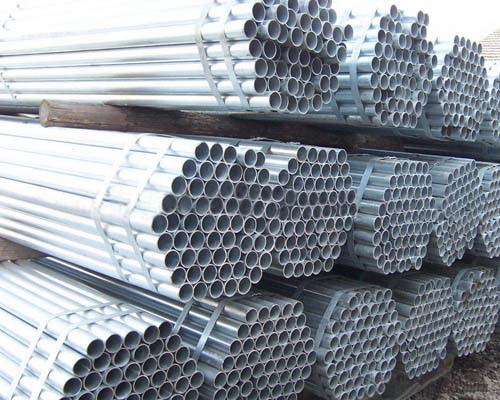In order to improve the service life of seamless pipes or welded pipes, steel pipe manufacturers often choose to galvanized pipes. There are two types of galvanized pipes: hot-dip galvanizing and electric galvanizing. Hot-dip galvanizing has a thick galvanized layer, which has the advantages of uniform coating, strong adhesion, and long service life. The cost of electro-galvanizing is low, the surface is not very smooth, and its corrosion resistance is much worse than that of hot-dip galvanized pipes.
Technical requirements for galvanized pipe
1. Grade and chemical composition
The grade and chemical composition of the steel used for galvanized steel pipes shall comply with the chemical composition of the steel used for black pipes.
2. Manufacturing method
The manufacturing method of the clarinet (furnace welding or electric welding) is selected by the manufacturer. Galvanizing adopts hot-dip galvanizing method.
3. Thread and pipe joint
(1) For galvanized steel pipes delivered with threads, the threads should be machined after galvanizing.
(2) Steel pipe joints shall comply with the provisions of YB 238; malleable cast iron pipe joints shall comply with the provisions of YB 230.
4. The uniformity of the galvanized layer The galvanized steel pipe should be tested for the uniformity of the galvanized layer. The steel pipe sample shall not turn red (copper-plated color) after being continuously dipped in the copper sulfate solution for 5 times.
5. Cold bending test The galvanized steel pipe with a nominal diameter not greater than 50mm should be subjected to a cold bending test. The bending angle is 90°, and the bending radius is 8 times the outer diameter. No filler is used during the test, and the weld of the sample should be placed on the outside or upper part of the bending direction. After the test, there should be no cracks and peeling off of the zinc layer on the sample.
6. Hydrostatic test The hydrostatic test should be carried out on the clarinet, and eddy current flaw detection can also be used instead of the hydrostatic test. The test pressure or the size of the comparison sample for eddy current testing shall comply with the relevant regulations.

Technical requirements for galvanized welded steel pipes for low-pressure fluid conveyance
1. The uniformity of the galvanized layer: the steel pipe sample shall not turn red (copper-plated color) after being continuously dipped in the copper sulfate solution for 5 times
2. Surface quality: The surface of the galvanized steel pipe should have a complete galvanized layer, and there should be no uncoated black spots and bubbles, and small rough surfaces and local zinc tumors are allowed.
3. Weight of galvanized layer: According to the requirements of the buyer, galvanized steel pipe can be used for the determination of the weight of the galvanized layer. The average value should not be less than 500g/square meter, and any sample should not be less than 480g/square meter.
Process characteristics of galvanized pipe
1. Optimization of sulfate galvanizing
2. Transformation of sulfate galvanizing
3. Fast deposition rate and excellent protection performance
4. Unique clean production
5. Particularity of electroplating equipment
Technical requirements for galvanized pipe
1. Grade and chemical composition
The grade and chemical composition of the steel used for galvanized steel pipes shall comply with the chemical composition of the steel used for black pipes.
2. Manufacturing method
The manufacturing method of the clarinet (furnace welding or electric welding) is selected by the manufacturer. Galvanizing adopts hot-dip galvanizing method.
3. Thread and pipe joint
(1) For galvanized steel pipes delivered with threads, the threads should be machined after galvanizing.
(2) Steel pipe joints shall comply with the provisions of YB 238; malleable cast iron pipe joints shall comply with the provisions of YB 230.
4. The uniformity of the galvanized layer The galvanized steel pipe should be tested for the uniformity of the galvanized layer. The steel pipe sample shall not turn red (copper-plated color) after being continuously dipped in the copper sulfate solution for 5 times.
5. Cold bending test The galvanized steel pipe with a nominal diameter not greater than 50mm should be subjected to a cold bending test. The bending angle is 90°, and the bending radius is 8 times the outer diameter. No filler is used during the test, and the weld of the sample should be placed on the outside or upper part of the bending direction. After the test, there should be no cracks and peeling off of the zinc layer on the sample.
6. Hydrostatic test The hydrostatic test should be carried out on the clarinet, and eddy current flaw detection can also be used instead of the hydrostatic test. The test pressure or the size of the comparison sample for eddy current testing shall comply with the relevant regulations.

Technical requirements for galvanized welded steel pipes for low-pressure fluid conveyance
1. The uniformity of the galvanized layer: the steel pipe sample shall not turn red (copper-plated color) after being continuously dipped in the copper sulfate solution for 5 times
2. Surface quality: The surface of the galvanized steel pipe should have a complete galvanized layer, and there should be no uncoated black spots and bubbles, and small rough surfaces and local zinc tumors are allowed.
3. Weight of galvanized layer: According to the requirements of the buyer, galvanized steel pipe can be used for the determination of the weight of the galvanized layer. The average value should not be less than 500g/square meter, and any sample should not be less than 480g/square meter.
Process characteristics of galvanized pipe
1. Optimization of sulfate galvanizing
2. Transformation of sulfate galvanizing
3. Fast deposition rate and excellent protection performance
4. Unique clean production
5. Particularity of electroplating equipment









